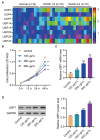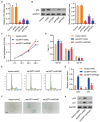Inhibition of USP7 suppresses advanced glycation end-induced cell cycle arrest and senescence of human umbilical vein endothelial cells through ubiquitination of p53
- PMID: 35538032
- PMCID: PMC9828104
- DOI: 10.3724/abbs.2022003
Inhibition of USP7 suppresses advanced glycation end-induced cell cycle arrest and senescence of human umbilical vein endothelial cells through ubiquitination of p53
Abstract
Diabetes mellitus is a n arising public health concern, and diabetic foot is one of the most common complications of diabetes. Current management for diabetic foot cannot reach optimal remission. In this study, we aim to explore the mechanism underlying the pathogenesis of diabetic foot and provide novel strategies for the treatment of diabetic foot. A total of 10 normal skin tissues and 20 diabetic foot ulcer specimens are collected. Cell proliferation is determined by CCK-8 assay. Cell cycle is determined by flow cytometry, and cell senescence is evaluated by β-galactosidase staining. Co-immunoprecipitation assay is used to explore the interaction between USP7 and p53. Advanced glycation end products (AGEs) are used to establish diabetic cell model, and streptozotocin (STZ) is used to establish diabetic rat model. Our results showed that USP7 expression is increased in diabetic foot ulcer and in human umbilical vein endothelial cells (HUVECs) after treatment with AGEs. Inhibition of USP7 can reduce cell cycle arrest and cell senescence in HUVECs. Moreover, USP7 can interact with p53 and promote its expression through mediating its deubiquitination. Knockdown of p53 can reverse USP7-mediated cell cycle arrest and cell senescence in HUVECs. In diabetic rats, HBX 41108, the specific inhibitor of USP7, can significantly accelerate wound healing. Our study reveals that the inhibition of USP7 can suppress AGEs-induced cell cycle arrest and cell senescence of HUVECs through promoting p53 ubiquitination. USP7 is a potential target for the treatment of diabetic foot ulcers.
Keywords: USP7; cell senescence; deubiquitination; diabetic foot; p53.
Conflict of interest statement
The authors declare that they have no conflict of interest.
Figures





Similar articles
-
Luteolin Alleviates Diabetic Foot Ulcers Through Improving KDM4C/ITGA1-mediated Functional Impairments of AGEs-Induced Senescent Endothelial Cell.J Biochem Mol Toxicol. 2025 Aug;39(8):e70437. doi: 10.1002/jbt.70437. J Biochem Mol Toxicol. 2025. PMID: 40778546
-
USP7 deficiency promotes diabetic wound healing by repressing GATA3-mediated pro-inflammatory macrophage polarization.Mol Cell Endocrinol. 2025 Apr 1;599:112489. doi: 10.1016/j.mce.2025.112489. Epub 2025 Feb 6. Mol Cell Endocrinol. 2025. PMID: 39921129
-
USP7-stabilised HIPK2 promotes high glucose-induced endothelial cell dysfunctions to accelerate diabetic foot ulcers.Arch Physiol Biochem. 2024 Dec;130(6):984-991. doi: 10.1080/13813455.2024.2376815. Epub 2024 Jul 27. Arch Physiol Biochem. 2024. PMID: 39066661
-
Recent advances on the intervention sites targeting USP7-MDM2-p53 in cancer therapy.Bioorg Chem. 2021 Nov;116:105273. doi: 10.1016/j.bioorg.2021.105273. Epub 2021 Aug 21. Bioorg Chem. 2021. PMID: 34474304 Review.
-
Targeting USP7-Mediated Deubiquitination of MDM2/MDMX-p53 Pathway for Cancer Therapy: Are We There Yet?Front Cell Dev Biol. 2020 Apr 2;8:233. doi: 10.3389/fcell.2020.00233. eCollection 2020. Front Cell Dev Biol. 2020. PMID: 32300595 Free PMC article. Review.
Cited by
-
Ubiquitin-Specific Proteases (USPs) and Metabolic Disorders.Int J Mol Sci. 2023 Feb 6;24(4):3219. doi: 10.3390/ijms24043219. Int J Mol Sci. 2023. PMID: 36834633 Free PMC article. Review.
-
USP7 Stabilizes USF1 to Aggravate ox-LDL-Induced Endothelial Injury Through the MYD88/NF-κB Pathway in Atherosclerosis.Appl Biochem Biotechnol. 2025 Jul 18. doi: 10.1007/s12010-025-05312-2. Online ahead of print. Appl Biochem Biotechnol. 2025. PMID: 40679551
-
New insights into the role of ubiquitination in angiogenesis (Review).Int J Mol Med. 2025 Feb;55(2):32. doi: 10.3892/ijmm.2024.5473. Epub 2024 Dec 20. Int J Mol Med. 2025. PMID: 39704208 Free PMC article. Review.
-
USP7 Inhibition Promotes Early Osseointegration in Senile Osteoporotic Mice.J Dent Res. 2025 Jan;104(1):86-96. doi: 10.1177/00220345241288570. Epub 2024 Dec 9. J Dent Res. 2025. PMID: 39651622
-
The Role of p53 in Regulating Chronic Inflammation and PANoptosis in Diabetic Wounds.Aging Dis. 2024 Feb 19;16(1):373-93. doi: 10.14336/AD.2024.0212. Online ahead of print. Aging Dis. 2024. PMID: 38377027 Free PMC article. Review.
References
-
- Lim JZ, Ng NS, Thomas C. Prevention and treatment of diabetic foot ulcers. J R Soc Med. . 2017;110:104–109. doi: 10.1177/0141076816688346. - DOI - PMC - PubMed
-
- Singh MR, Saraf S, Vyas A, Jain V, Singh D. Innovative approaches in wound healing: trajectory and advances. Artificial Cells Nanomed Biotechnol. . 2013;41:202–212. doi: 10.3109/21691401.2012.716065. - DOI - PubMed
-
- Galkowska H, Wojewodzka U, Olszewski WL. Chemokines, cytokines, and growth factors in keratinocytes and dermal endothelial cells in the margin of chronic diabetic foot ulcers. Wound Repair Regen. . 2006;14:558–565. doi: 10.1111/j.1743-6109.2006.00155.x. - DOI - PubMed
MeSH terms
Substances
LinkOut - more resources
Full Text Sources
Medical
Molecular Biology Databases
Research Materials
Miscellaneous

